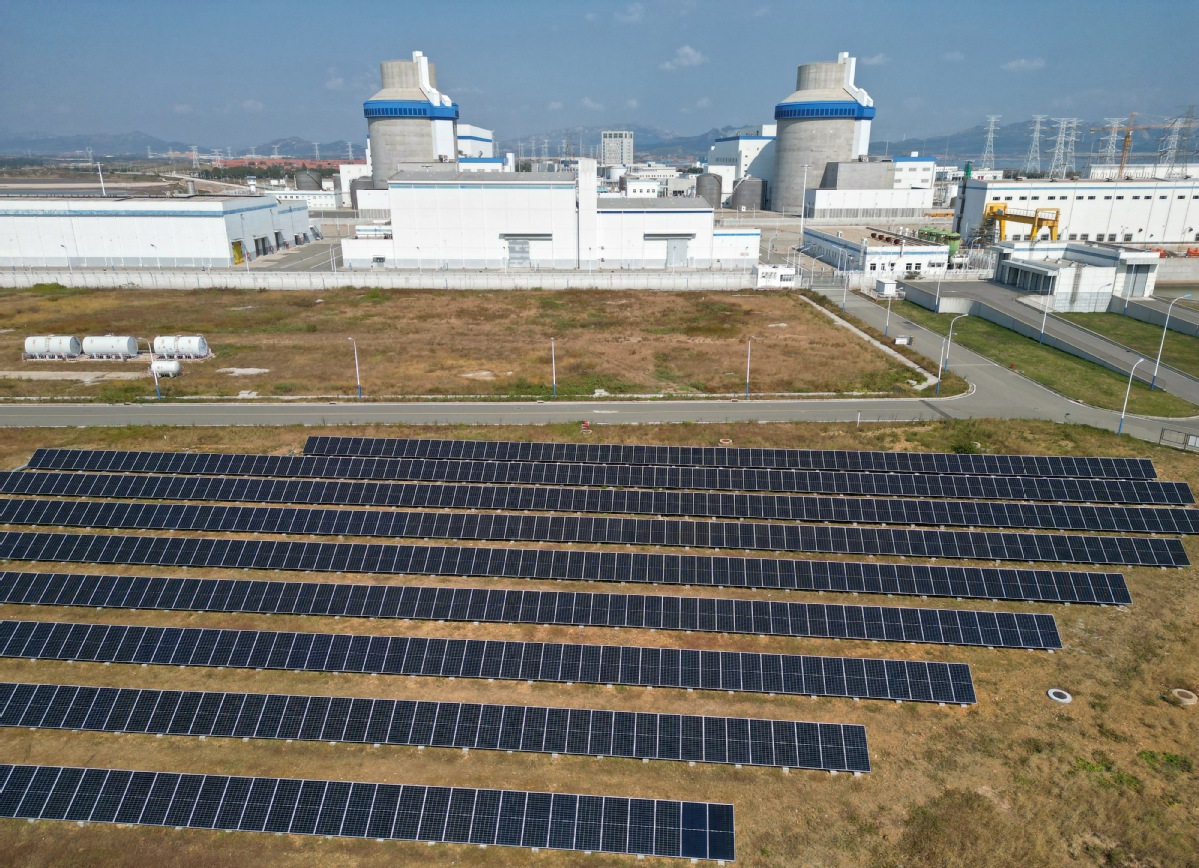Cleaner heating plants getting hotter


Nuclear, biological and geothermal projects playing significant role in China's green goals
Green energy is expected to contribute more to clean heating in China, as the Chinese government calls for large-scale new energy deployment to further facilitate its 2060 carbon neutrality goal.
Two nuclear power heating projects — one in Haiyang, Shandong province, and one in Dalian, Liaoning province — have been deployed for heating since November, covering a total area of more than 5 million square meters.
The Haiyang plant, China's largest nuclear power-based heating project, will provide clean heating for 200,000 residents this winter in the county-level city in Yantai, according to Shandong Nuclear Power Co, a subsidiary of State Power Investment Corp and also the plant's operator.
The project, which is also the country's largest single-unit steam extraction heating plant, will soon expand to cover all of the Jiaodong peninsula, it said. The third phase of its 900-megawatt nuclear heating project is under construction and expected to start providing clean heating by 2023, covering an area of 30 million square meters, said Liu Yongde, chief engineer of State Power Investment Corp.
That will be equivalent to replacing 900,000 metric tons of standard coal and reducing carbon dioxide emissions by 1.65 million tons, he said.
By connecting a nuclear plant's heating system to traditional nuclear units, the project extracts nonradioactive steam from the circuit of nuclear units, which is then fed through a multistage heat exchanger in an on-site station. The heat is then transferred to an off-site heat exchange station belonging to a local thermal power company, where heated water flows through municipal heating pipes to consumers, he said.
While winters in North China used to be marked by smoggy skies and poor air quality due to the extensive burning of coal for heating, the widespread adoption of clean energy has changed the situation substantially, he said.
In addition, China National Nuclear Corp, operator of the first nuclear heating demonstration project in Haiyan county, East China's Zhejiang province, plans to cover 4 million square meters by 2025.
Nuclear heating is growing around the world as the output of nuclear power is nonstop, said Wei Hanyang, a power market analyst at BloombergNEF.
"China seeks to gradually reduce coal use in the heating sector, but natural gas as a replacement still produces carbon emissions. This makes nuclear power an effective option for meeting the country's decarbonization ambitions," he said.
Heating accounts for approximately 20 percent of total energy use in buildings in China, making it the most significant carbon emitter in that sector, according to RMI, an independent nonprofit organization focusing on the transition to clean energy.
Reducing the use of traditional heating energy is crucial for reaching China's 2060 climate goal of carbon neutrality, the organization said.
Nuclear projects are only part of the nation's efforts to decarbonize the heating sector. Chinese energy companies are gearing up to expand other clean energy-based heating projects in more areas in the country as renewable energy development accelerates in China, officials said.
In Lingqiu county, Shanxi province, State Power Investment Corp is working on the country's largest wind power heating demonstration project. It is expected to provide clean heating for 2,312 local residents and 135 commercial clients this year, the company said.
The project will not only increase the capacity of northern regions to make better use of great quantities of available wind power, but also promote clean energy use in urban areas while reducing the negative effects of burning fossil fuels, it said.
China has many renewable energy resources, and the company is determined to further tap them to facilitate the country's carbon peak by 2030, officials said.
State Power Investment Corp said its total installed capacity exceeded 200 million kilowatts by the end of August, with installed capacity for clean energy accounting for 62.5 percent of that, it said.
China Petrochemical Corp, also known as Sinopec and the world's largest refiner by volume, has for years been developing the nation's geothermal energy. With more than 700 heating stations, the company's geothermal heating service covers nearly 85 million square meters in more than 60 cities and counties in Tianjin and in Shaanxi, Hebei, Henan, Shandong, Shanxi, Hubei and other provinces.
The country has also been developing biomass for heating, helping reduce reliance on fossil fuels and diversifying energy sources, officials said.
Agricultural and forestry products, organic household waste, as well as livestock and industrial refuse, are some of the biological materials used as fuels in producing electricity and heat.
Under the energy efficiency and carbon intensity targets set by the Chinese government, the country's development of biomass energy will be fast-tracked thanks to preferential policy support, experts said.
According to Zhang Dayong, secretary-general of China's Biomass Energy Industry Promotion Association, the development of the biomass energy industry has ushered in an important opportunity under China's strong green commitment. The industry has great potential for further growth, he said.
By the end of 2020, there were 8,200 enterprises engaged in businesses related to clean heating in China, with a total output valued at 900 billion yuan ($129.24 billion) and more than 1.19 million employees, according to the China Association of Building Energy Efficiency.
"Clean and renewable energy is part of China's efforts in striving toward a low-carbon economy," said Luo Zuoxian, head of intelligence and research at the Sinopec Economics and Development Research Institute.
"China has been stepping up efforts to promote clean heating and ensure that clean energy is used for heating in more than 70 percent of the households in northern China," he said.
"The use of clean heating in the southern part of the country will also be explored."




































